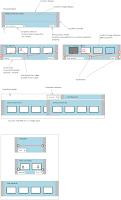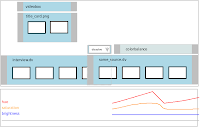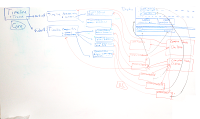 I've been working on the design a bit more. The top part of the diagram is an anatomical description of what objects in the advanced timeline should look like. Ideally I'd like all objects to support keyframeable properties, not just effects. This will require some changes to PiTiVi core -- in particular, all timeline objects will have to support getting/setting keyframes, which means internally they'll all have gst-controller objects. Personally, I think that's fine: one thing people overwhelmingly seem to want is to be able to directly control image opacity and audio volume.
I've been working on the design a bit more. The top part of the diagram is an anatomical description of what objects in the advanced timeline should look like. Ideally I'd like all objects to support keyframeable properties, not just effects. This will require some changes to PiTiVi core -- in particular, all timeline objects will have to support getting/setting keyframes, which means internally they'll all have gst-controller objects. Personally, I think that's fine: one thing people overwhelmingly seem to want is to be able to directly control image opacity and audio volume.One thing I'm not quite sure how to handle, though, are simple effects. You see, Edward's paper notes suggest that simple-effects (effects which only take one source as input) should appear in a small gutter above the other timeline objects within a given layer. This gutter would also be used for transitions. But this design leaves no room for over-laying keyframes, unless we allow simple-effects to expand to full height. But if we do that it will be difficult to distinguish beween simple effects and complex effects. So, perhaps *all* effects should simply be full-size objects , as in the above design. One thing I don't like about this, though, is that it's actually kinda hard to tell what's going on. Will videobox apply to just the image source directly below it, or the entire composition?

So, I came up with a different design. Move the properties down below the timeline, but keep them in sync with the timeline's scroll position. Now all objects can have as many properties as they want, and they can be kept completely separate from each other (or they could show as overlapping curves, I'm not yet sure which is best. The idea is that you select an object (in this image, the lighter colored simple effect is selected), and the property viewer displays its property graph. If you select multiple objects, one of two things could happen: it could show the intersection of the properties of all selected objects and let you set the same keyframe/values for all selected objects; or the property browser could display the properties of all selected objects individually. Ideally you'd want some combination of both, but I can't think of an elegant way to do that just yet.
Details: In either design, whenever you adjust a property, the viewer should show a preview of the keyframe after the effect has been applied.





